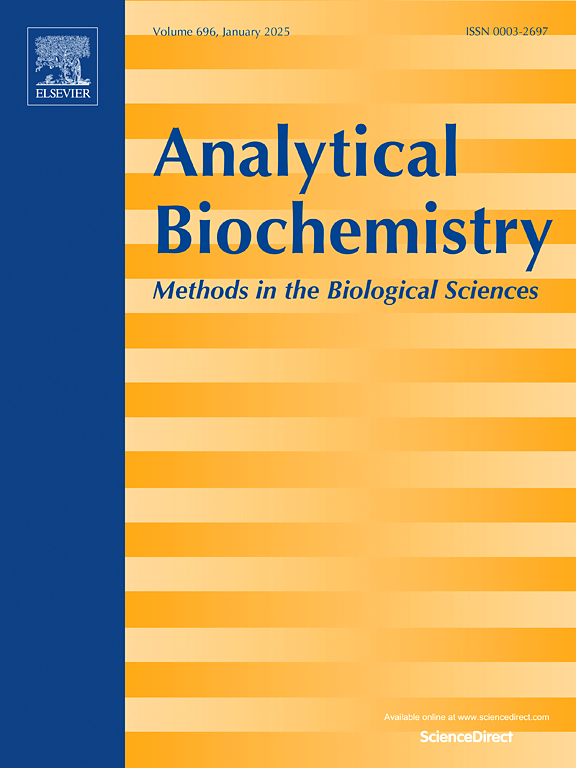A proof-of-concept diagnostic platform for neonatal calf diarrhea using serum infrared spectroscopy and predictive analytics
IF 2.5
4区 生物学
Q2 BIOCHEMICAL RESEARCH METHODS
引用次数: 0
Abstract
This study presents a novel diagnostic platform for the rapid and non-invasive detection of neonatal calf diarrhea using ATR-FTIR spectroscopy combined with predictive analytics. Neonatal calf diarrhea is a leading cause of economic losses and animal welfare issues in the cattle industry, and current diagnostic methods are often time-consuming and require invasive sampling. Our approach leverages the unique biochemical fingerprints of serum obtained from healthy, diseased, and recovered calves. The spectral data were preprocessed and analyzed using Principal Component Analysis to extract key molecular features, which were subsequently classified using Linear Discriminant Analysis and Support Vector Machines. These predictive models demonstrated high accuracy in distinguishing the physiological states of the calves, underscoring the potential of this platform as a reliable diagnostic tool. Another significant innovation of this work is the development of the 1080 cm−1/3300 cm−1 spectrochemical index, a single, interpretable parameter derived from the ratio of the PO2− symmetric stretching band to the Amide A band. This quantitative index correlates with molecular-level changes associated with disease progression and recovery, further enhancing diagnostic precision and enabling timely intervention. The integration of spectral data into an easily interpretable metric contributes to improved animal welfare and sustainable livestock management practices.

使用血清红外光谱和预测分析的新生儿小牛腹泻的概念验证诊断平台
本研究提出了一种新的诊断平台,利用ATR-FTIR光谱结合预测分析,快速、无创地检测新生儿小牛腹泻。在养牛业中,新生儿小牛腹泻是造成经济损失和动物福利问题的主要原因,目前的诊断方法往往耗时且需要侵入性采样。我们的方法利用从健康,患病和恢复小牛获得的血清的独特生化指纹。对光谱数据进行预处理和主成分分析,提取关键分子特征,然后使用线性判别分析和支持向量机进行分类。这些预测模型在区分小牛的生理状态方面表现出很高的准确性,强调了该平台作为可靠诊断工具的潜力。这项工作的另一个重要创新是开发了1080 cm−1/3300 cm−1光谱化学指数,这是一个单一的,可解释的参数,来自PO2−对称拉伸带与酰胺a带的比值。这一定量指标与与疾病进展和恢复相关的分子水平变化相关,进一步提高了诊断准确性并使及时干预成为可能。将光谱数据整合为易于解释的度量有助于改善动物福利和可持续的牲畜管理做法。
本文章由计算机程序翻译,如有差异,请以英文原文为准。
求助全文
约1分钟内获得全文
求助全文
来源期刊

Analytical biochemistry
生物-分析化学
CiteScore
5.70
自引率
0.00%
发文量
283
审稿时长
44 days
期刊介绍:
The journal''s title Analytical Biochemistry: Methods in the Biological Sciences declares its broad scope: methods for the basic biological sciences that include biochemistry, molecular genetics, cell biology, proteomics, immunology, bioinformatics and wherever the frontiers of research take the field.
The emphasis is on methods from the strictly analytical to the more preparative that would include novel approaches to protein purification as well as improvements in cell and organ culture. The actual techniques are equally inclusive ranging from aptamers to zymology.
The journal has been particularly active in:
-Analytical techniques for biological molecules-
Aptamer selection and utilization-
Biosensors-
Chromatography-
Cloning, sequencing and mutagenesis-
Electrochemical methods-
Electrophoresis-
Enzyme characterization methods-
Immunological approaches-
Mass spectrometry of proteins and nucleic acids-
Metabolomics-
Nano level techniques-
Optical spectroscopy in all its forms.
The journal is reluctant to include most drug and strictly clinical studies as there are more suitable publication platforms for these types of papers.
 求助内容:
求助内容: 应助结果提醒方式:
应助结果提醒方式:


